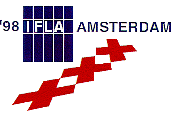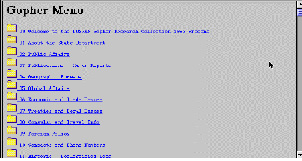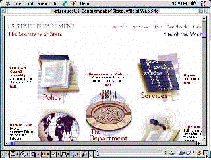
As of 22 April 2009 this website is 'frozen' in time — see the current IFLA websites
This old website and all of its content will stay on as archive – http://archive.ifla.org

As of 22 April 2009 this website is 'frozen' in time — see the current IFLA websites
This old website and all of its content will stay on as archive – http://archive.ifla.org




alt="Chart" width="569" height="393"

This paper uses a case study of the University of Illinois at Chicago (UIC) University Library and its efforts at providing outsourced services to a variety of clients in the corporate and governmental sectors. Because librarians have spent so much effort to simplify our own information processes while at the same time enriching the ability of our users to find information, we have many skills that are very useful in today's electronically networked information economy. Because librarians understand not only the basic properties of information but are also able to view information-seeking from the seekers point-of-view, we are well-skilled to provide unique, valuable assistance to organizations for whom information is a basic commodity. It was in the context of the U.S. Department of State's need to make a large amount of constantly changing and expanding information widely available in a timely and useful manner that the UIC University Library undertook a partnership with the U.S. Department of State to publish State Department documents on the Internet.
While we experimented with different organizations for the first site, UIC needed to identify methods for the daily secure transfer of data from Washington to Chicago in a timely fashion; to train staff in Chicago and Washington about managing Internet resources; and, to install and support the library's first standalone server.
An important early step was to consider how the staff in Washington would send the documents to Chicago in a timely manner. Colleagues at the Coalition for Networked Information (CNI) in Washington, DC assisted the Library and the State Department in trying out several Internet suppliers because the State Department's secure network did not allow routine access beyond the confines of a network designed to be secure from a military point-of-view. In fact, the open network of the university - the thing that made the partnership attractive - was considered reasonable primarily because the more than 700 miles that separated Chicago from Washington, D.C. made the State Department security staff see clearly that there was no threat to their internal network.
While we tried various ways to transfer the data from Washington to Chicago, the data that the State Department had already issued on CD-ROMs was converted to text formats of suitable length and style for presentation over the Internet. Initially the protocol that was selected was the Internet Gopher protocol because it allowed large chunks of text to be sent efficiently across great distances via slow connections. The UIC partners learned that security of the network, integrity of the documents, and ease of transmission were going to be the paramount concerns of our colleagues in Washington. In Chicago, we were concerned that we would provide a high quality service, that we would be responsive to the State Department's needs, and that we would be able to provide, via the Internet, timely and easy access to documents that were generally only available in libraries or through the U.S. Government Printing Office. Early on, however, we learned that we would be providing access to some documents, the daily press briefings, that were reviously only available to the limited number of the press admitted to the daily press conference held at the State Department and then through an annual cumulation on CD-ROM.
Once we had established a way of using file transfer protocol (ftp) over phone lines through an intermediary vendor, we could turn our attention to the documents. We began to see the wide variety of documents that would be provided - varying sizes and complexity - and we decided to help our colleagues develop a standard header and footer for documents was developed. The header gives documents a consistent look and the special footer lets users know that they have managed to download/receive a complete copy of the file. The footer is especially important when documents are averaging more than 150kb each. While UIC tried to convince our partners that breaking the documents into smaller chunks would serve the users better, State Department staff taught us that integrity and wholeness of the documents was very important to them and their clients. We also recognized that whole documents were attractive to users wanting to make a paper copy of a document. Today major publications are offered in text and word-processed versions, in Adobe's Portable Document Format, and marked-up in HyperText Markup Language. They are available via electronic mail, anonymous file transfer protocol, Internet gopher, and hypertext transfer.
Daily transmission of current documents via electronic mail and ftp was monitored to develop a secure process for the transmission of files. Ultimately a staged approach to the delivery and posting of documents was developed. Staff at the State Department prepare the documents for posting and deliver the prepared documents to a staging area on a separate machine at UIC. The presence of these documents for review before loading onto the live server is communicated through electronic mail confirmations. UIC library staff open the confirmed documents, review the markup for conformance to international standards, for possible typos or other errors, as well as conformance to the stylesheet we have co-developed, and then use a local area network at the UIC library to place the items out for public access.

gopher://gopher.state.gov that has a Web front-end (the Electronic Research Collection) at
http://dosfan.lib.uic.edu . Even today, text versions of important new documents are added to the Gopher to allow those with slower connections to gain easy access to the information.
The library staff and the State Department agreed to make the switchover to the World Wide Web protocol late in 1994 giving birth to http://www.state.gov . During the development of the Web site, UIC staffers added indexing and searching capabilities to the server and developed a way for visitors to leave comments and ask questions. Graphics were developed by the State Department staff and then refined by UIC staff to load more quickly over slow connections. Image maps to allow visitors to click on graphics and retrieve documents were developed and text only versions of navigation pages were created. A counter of visitors was used briefly for about 3 months, but with more than 2.000,000 visits per month from more than 100 countries, it was decided that dedicating computer time to merely update the counter was unnecessary.

The popularity of the Web site led the Department to undertake a very serious upgrading of the layout and graphics of the site in 1997. An outside consultant was hired to make the prototype of the new site, but it was the UIC librarians that assisted the State Department in figuring out how to make a smooth transition from the old site to new and how to make all the new features function well within the established framework.
The UIC Library is also reconsidering its role from government depository library to partner with the U.S. Government Printing Office. We take our responsibility to archive and distribute yesterday's foreign policy very seriously as we develop policies for the historical archive. As UIC librarians have become more involved in addressing these issues, a new role for the library is emerging. The library has become the distributor of information online, moving this function from a locally-based one designed just for our library's own clients to a national, and even international, one serving many information seekers from around the world. This new function of the library - as electronic publisher - has evolved thanks to the comparatively lower start-up costs of electronic publication/distribution over publication/distribution of paper information and by the library's strong desire to provide off-site access to information. The electronic distribution of information is a natural evolution from our role as keeper of the printed books, and yet instead of reviewing the quality of printed works, we now find ourselves able to go beyond the role of providing access via our catalogue surrogate into the actual shaping and definition of the information itself.